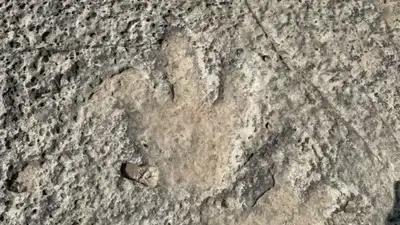ARTICLE AD BOX

Floodwaters in the Texas Hill Country have uncovered a remarkable prehistoric discovery, rare dinosaur prints buried for more than a century beneath layers of soil and rock. According to CNN, a devastating flood in early July exposed 15 three-clawed footprints along a newly revealed creek bed in the Big Sandy Creek area of Travis County.A volunteer clearing debris reportedly spotted the tracks, which were later confirmed by experts to have been made by a large, meat-eating dinosaur. At the landowner’s request, the exact location of the find, on private property, is being kept confidential.Matthew Brown, a paleontologist at the University of Texas at Austin, said the tracks likely belonged to an Acrocanthosaurus, a bipedal carnivore that measured about 35 feet in length.
The footprints, which range from 18 to 20 inches long, are estimated to be between 110 and 115 million years old. They were preserved in limestone from the Glen Rose Formation, a rock layer frequently associated with Cretaceous-period fossils.
Disaster and discovery in “flash flood alley”

Source: X
The Sandy Creek area, part of a region known as “Flash Flood Alley” for its vulnerability to sudden, intense flooding, was among the hardest-hit in the recent disaster. In early July, torrential rains swelled the usually dry creek to 20 feet, sweeping away homes, property, and lives.
Officials reported over 135 deaths in the Texas Hill Country, including at least 36 children at nearby Camp Mystic in Kerr County. Travis County recorded 10 deaths from the flooding.Despite the scale of the tragedy, the dinosaur tracks have sparked excitement among paleontologists and locals alike. County and state officials, under the guidance of scientists, are working to safeguard the site from damage by cleanup crews and heavy machinery.
Preserving the past with 3D imaging

Representative Image
Brown and his team plan to return to the site soon to conduct detailed mapping and 3D imaging of the footprints. The volunteer who found them noted that the tracks formed a crisscross pattern, something researchers hope will help determine whether they were made by a single dinosaur or a group moving through the area.“Dinosaur tracks are common in central Texas,” Brown said, adding that many people are surprised to learn they might find them “in their own backyards.”
Nearby finds have included prints from the Paluxysaurus, a large herbivorous sauropod and Texas’ official state dinosaur.Travis County lies just under 200 miles south of Dinosaur Valley State Park, famous for its abundance of sauropod and theropod tracks left around 113 million years ago. The park attracts tourists year-round who, in normal conditions, explore the now-dry Paluxy River for swimming, fishing, and kayaking, and to catch a glimpse of the ancient footprints that connect Texas to its deep prehistoric past.



.png)
.png)
.png)
















 3 hours ago
4
3 hours ago
4









 English (US) ·
English (US) ·